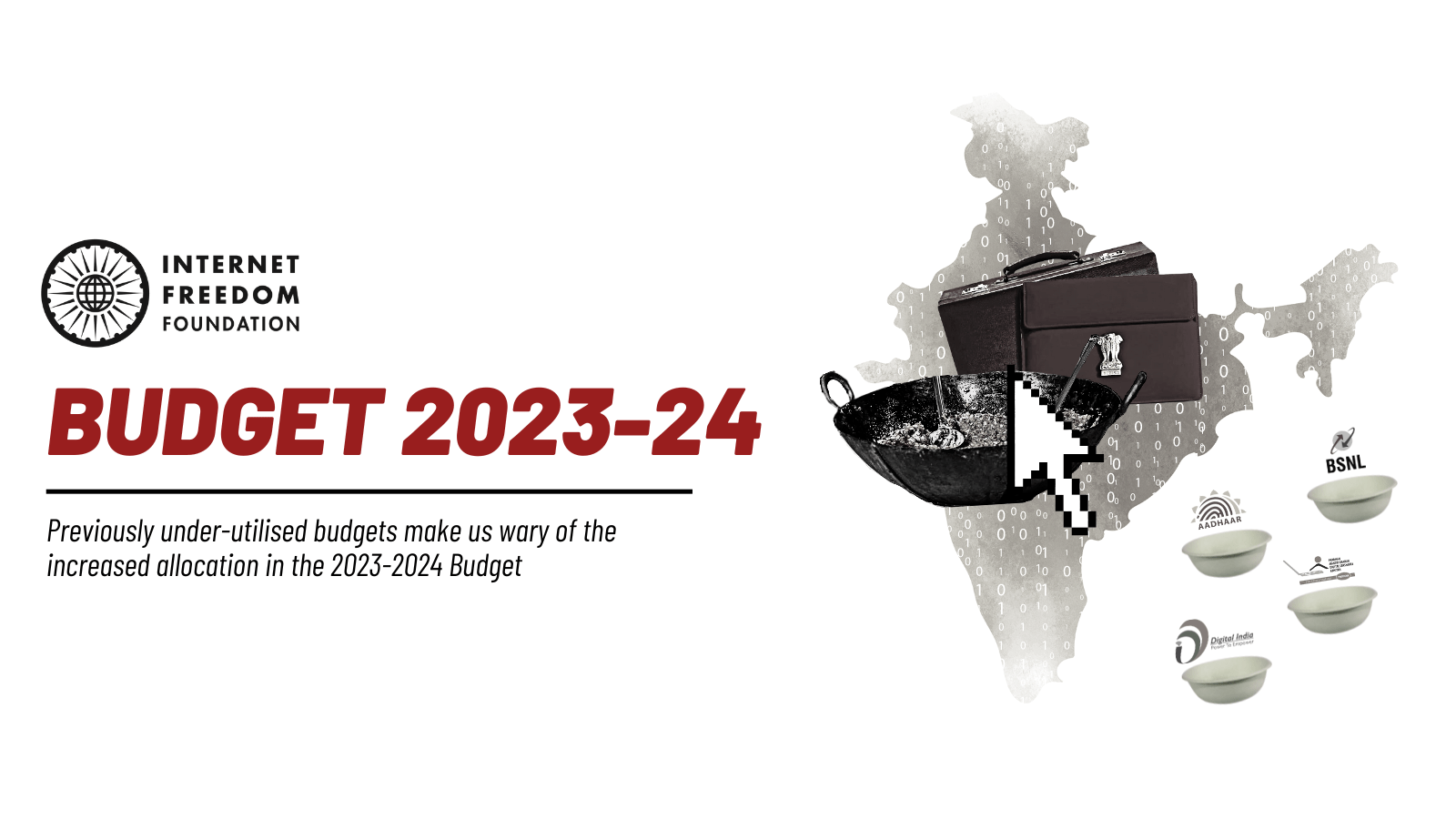
tl;dr
Increased allocations in the 2023-24 Budget as compared to the 2022-2023 Budget is a positive sign. The budgetary allocation by MeitY has witnessed the highest increase of 41.2%, however, this increase is accompanied with complete discontinuation of fund allocation towards PMGDISHA, which is a rural digital literacy scheme. Furthermore, the trend of decreasing fund allocation in revised estimates and under-utilisation of funds in 2022-2023 is a cause of worry. It remains to be seen if the same trend will be witnessed in the FY 2023-2024.
Introduction
The Budget for the Financial Year (FY) 2023-2024 was presented on February 01 in the ongoing Budget Session that commenced on January 31, 2023. The Session, which is set to last for 27 days, will happen in 2 parts, the 1st is scheduled to end on February 13 and the second part will happen between March 13 and April 06. The Union Government plans to introduce 19 new bills in the ongoing Budget Session, one of which might be the draft Digital Personal Data Protection Bill, 2022, as per very recent news reports.
A Broad Picture
Union Budget for Financial Year 2023-24 has cumulatively allotted ₹ 1.25 lakh crores to the National Health Mission (NHM), the Ministry of Electronics and Information Technology (MeitY), the Ministry of Information and Broadcasting (MIB), the Department of Telecommunications (DoT), and Ministry of Home Affairs (MHA):
- For the MeitY, allocation in Budget Estimates (BE) 2023-2024 (₹ 16549 crores) saw an increase of 41.20% as compared to the Revised Estimates (RE) of 2022-23 ( ₹ 11720 crores).
- For the MHA, allocation in BE 2023-2024 (₹ 5901.31 crores) saw an increase of 7.83% as compared to the RE of 2022-23 (₹ 5472.44 crores).
- For the NHM, allocation in Budget Estimates (BE) 2023-2024 (₹ 341.02 crores) saw an increase of 143.58% as compared to the Revised Estimates (RE) of 2022-23 (₹ 140 crores).
- For the MIB, allocation in Budget Estimates (BE) 2023-2024 (₹ 4692 crores) saw an increase of 12.19% as compared to the Revised Estimates (RE) of 2022-23 (₹ 4182 crores).
- For the DoT, allocation in Budget Estimates (BE) 2023-2024 (₹ 97579.1 crores) saw an increase of 19.25% as compared to the Revised Estimates (RE) of 2022-23 (₹ 81821.1 crores).
- An enormous 64.77% increase in total planned capital expenditure of DoT, MeitY, MHA, and MIB (₹ 62,845.61 crores) over the RE of 2022-23 (₹ 38,139.55 crores) can be observed, stemming largely from a 65.63% increase in the DoT. The increment can be attributed to DoT’s capital allocation towards wireless planning and coordination, which increased by 50 times as compared to 2022-23.
Ministry of Electronics and Information Technology (MeitY)
Table 01: Budgetary allocations for specific items
The total budgetary allocation for MeitY in the Budget for 2023-2024 is ₹ 16549.04 cr, this is a 15.73 % increase from the previous financial year budget. The increase is even higher when compared to the RE of 2022-2023, i.e., a year-on-year change of 41.2%. This is in contrast to the budgetary trends we witnessed in 2021 wherein, there was under-utilisation of the budget. We appreciate the decision to increase budgetary allocation to MeitY in the FY 2023-2024 and hope to see these funds be directed towards infrastructure development aimed at increasing tele-connectivity and broadband connectivity, as well as overall digital literacy.
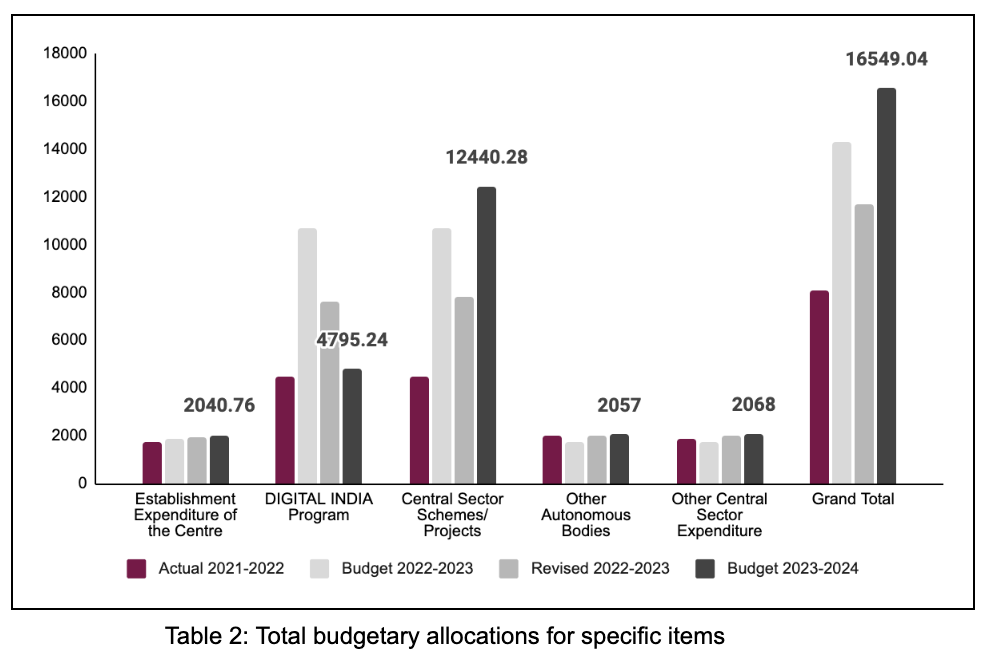
Allocation towards the Digital India Program reduced to ₹ 4795.24 crores in the 2023-2024 BE, witnessing a massive decrease of 55.08% and 36.93% in comparison to the allocation made in 2022-2023 BE and RE respectively. The decrease can mainly be attributed to reduction in allocation towards Promotion of Electronics and IT HW Manufacturing, PLI for Large Scale Electronics and IT Hardware, and Pradhan Mantri Gramin Digital Saksharta Abhiyan (PMGDISHA).
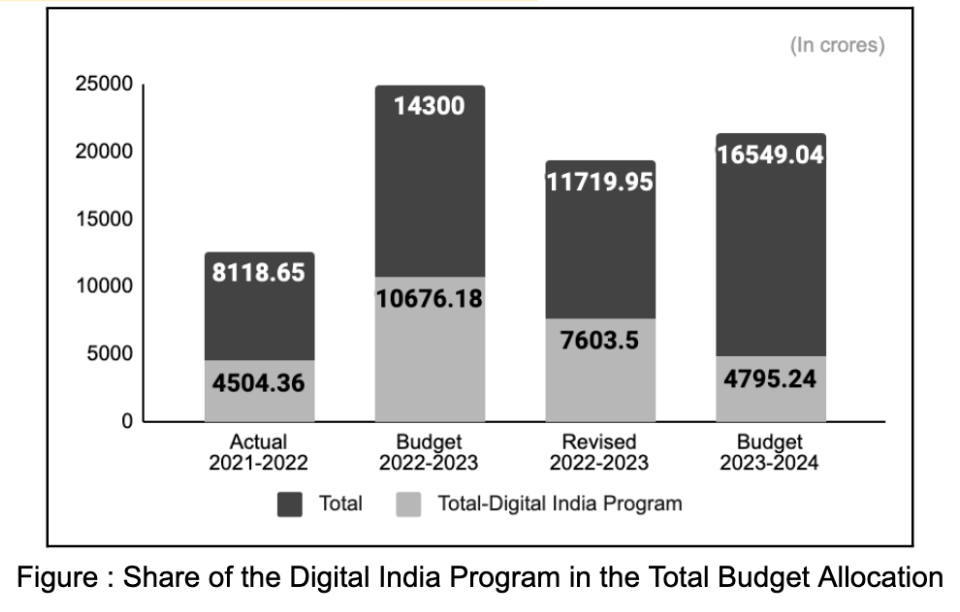
On a very disappointing note, MeitY has not allocated any funds towards PMGDISHA in the 2023-2024 Budget. This is the first time since 2017 that no fund has been allocated towards the rural digital literacy scheme. We noted our concerns last year, when the allocations to it were at an all time low since 2018-2019. The last impact assessment study of PMGDISHA was carried out by Indian Institute of Public Administration (IIPA) in 2020-21. The report concluded that the scheme, as a digital literacy programme, “plays an indispensable part in not only bridging the digital gap in the country but also transforming it into a knowledge economy and society.”The allocations made to this scheme must increase in order to ensure its effective progress and robust digital literacy in the country.
Perplexingly, the allocation to Promotions of Digital Payments has plummeted to Rs. 1500 crores as compared to ₹ 2137 crores allocated to it in the 2022-2023 RE, reflecting a decline of 29.8%. It must be noted that revised allocations increased sharply in 2022-2023 (₹ 2137 crores), witnessing a jump of 968.5% as compared to the 2022-2023 BE which stood at Rs. 200 crores. Even though the allocation in 2023-2024 is higher than the previous year’s BE, the former is still lower than the RE. The Finance Minister in their Budget speech for this FY noted that “Fiscal support for this digital public infrastructure (digital payments) will continue in 2023-24.”
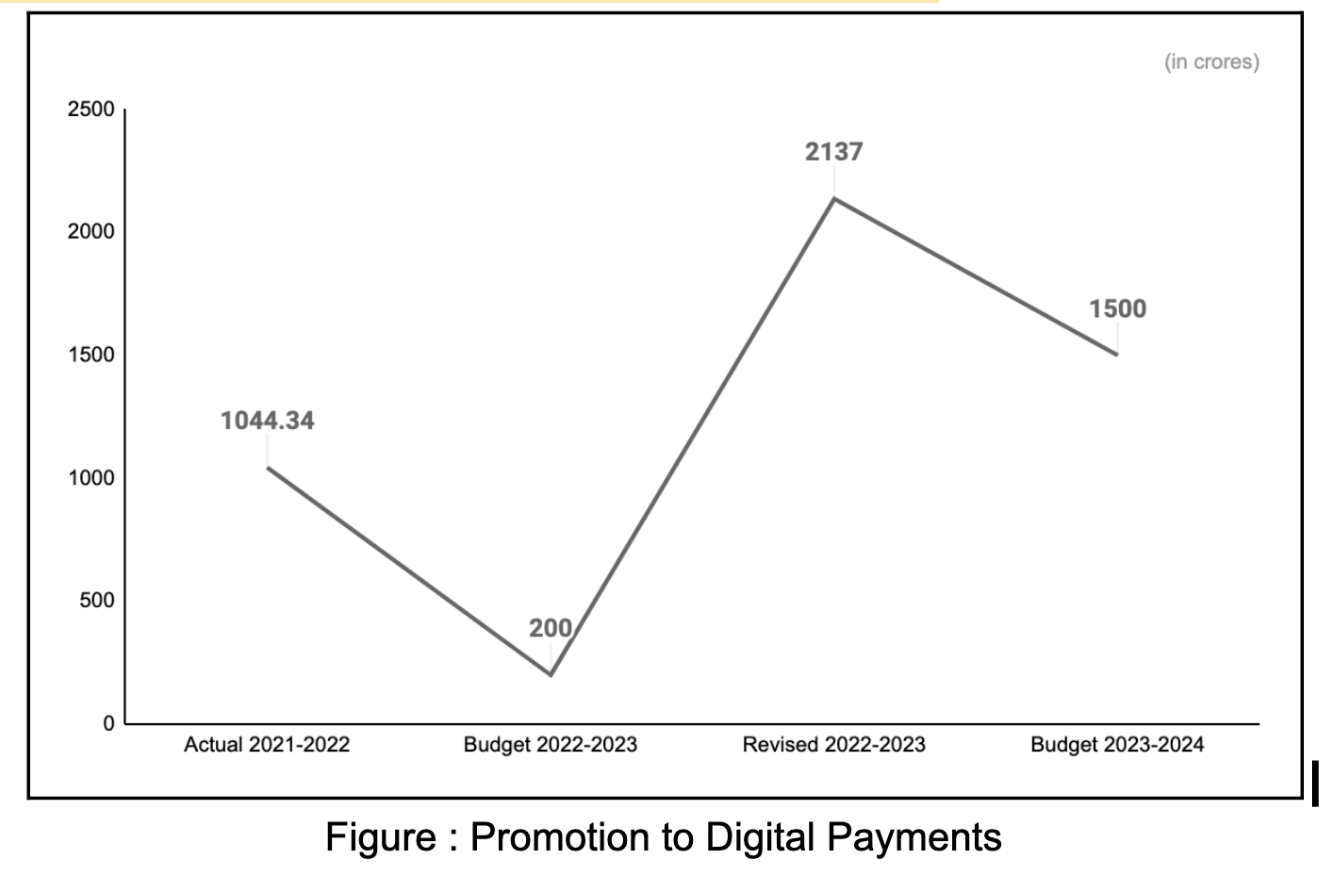
The allocation to National Informatics Centre (NIC) in 2023-2024 BE has increased to ₹ 1527.26 crores, as compared to ₹ 1463.45 crores allocated in the 2022-2023 RE, and ₹ 1450 crores allocated in the 2022-2023 BE.
Allocations towards CERT-In leave us with mixed feelings. While the allocations increased in 2023-2024 to ₹ 225 crores from ₹ 180 crores in 2022-2023 RE, the latter witnessed a decreased allocation of 16.27% as compared to the 2022-2023 BE (₹ 215 crores).
Allocation to the Unique Identification Authority of India (UIDAI) decreased by 14.54% in 2023-2024 BE as compared to the 2022-2023 RE. The allocation in this FY is 39.92% less than what was actually utilised in 2021-2022, i.e. 1564.8 crores.
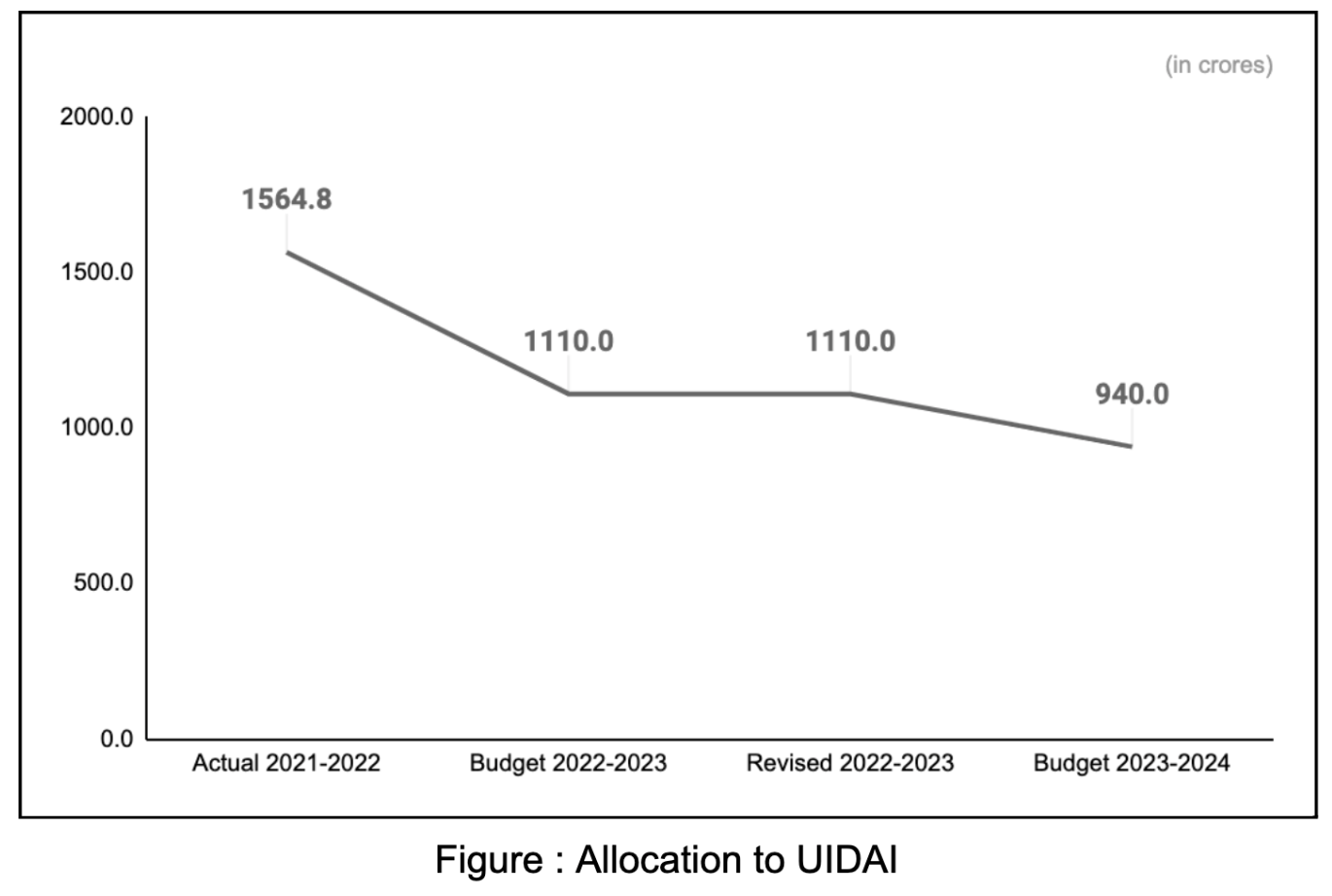
Ministry of Home Affairs (MHA)
The Total budgetary allocation for MHA is 22% lower than what was allocated in the BE for the FY 2022-23. The allocation in the budget estimates, net of receipts and recoveries, for MHA is ₹ 5901.31 crores. Although there is a 32.65% increase over the 2022-23 RE that was pegged at ₹ 4448.77 crores, the allocation is still 22.56% lower than what was made in 2022-23. Despite the overall decrease in the budgetary allocation, the allocation for planned capital expenditure has increased considerably as compared to both the 2022-2023 BE (by 81.43%) and RE (by 97.16%). There has been a marginal hike in the allocation for the ministry, with the majority of the funds getting directed towards NATGRID, cyber crime, immigration tracking and border management.
Table 02: Budgetary allocations for specific items
A substantial jump can be noted in the total allocation for the census which is 183.11% from the RE 2022-23 (₹ 552.65 crores). However, the budget suffered a cut of 57.42% when compared to the ₹ 3,676 crores allocated in 2022-23.
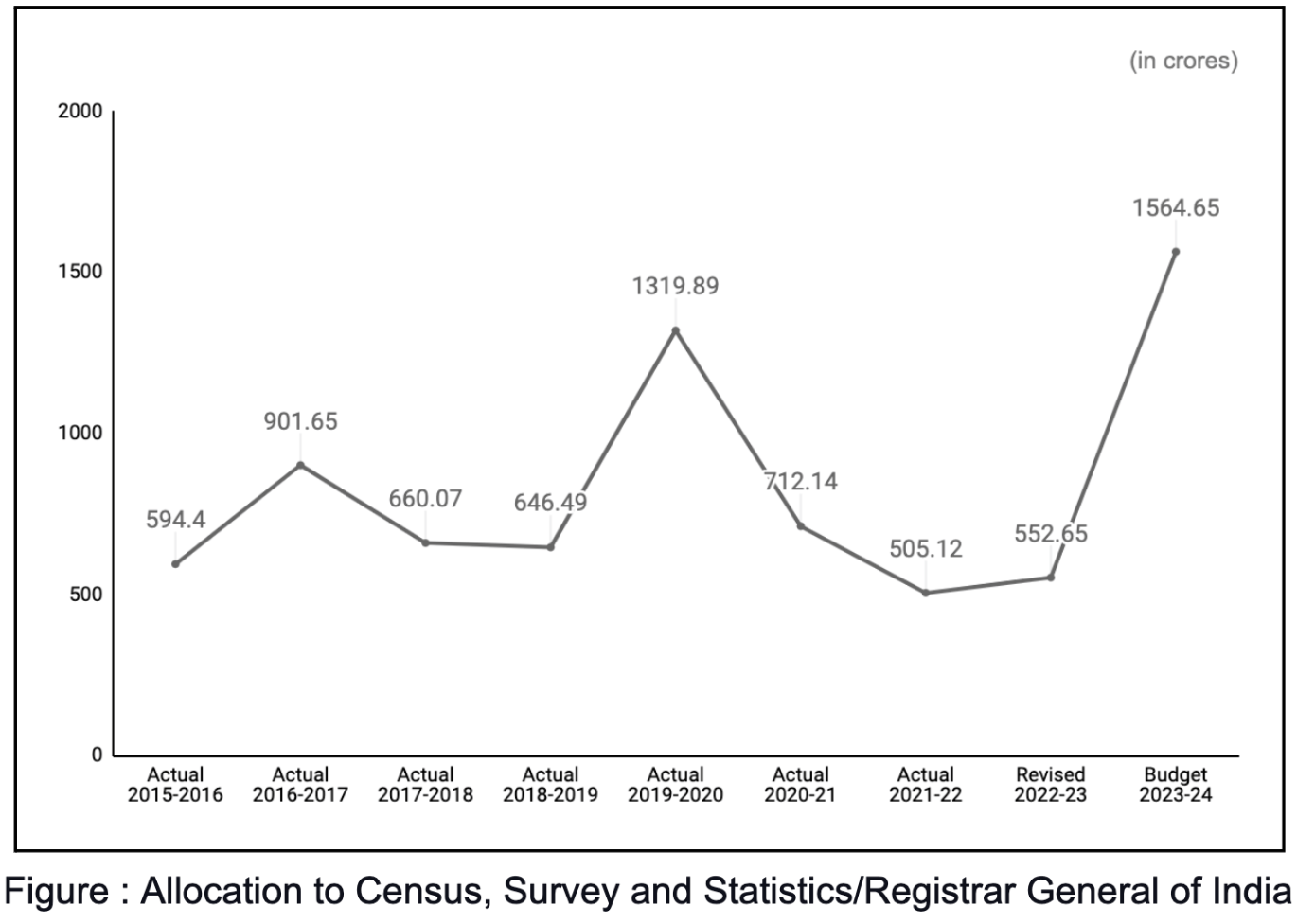
The allocation for the National Intelligence Grid (NATGRID) has grown substantially by 128% from ₹ 87.77 crore in 2022-23 to ₹ 200.53 crore in 2023-24. The Intelligence Bureau saw an increase of 7.8% with an allocation of ₹ 3,418.32 crore in 2023-24 from 2022-23 (₹ 3168.36).
The Indian Cyber Crime Coordination Centre has been allocated ₹ 94.40 crore which is 60% more than the budget allocated in 2022-23 (₹ 59 crores).
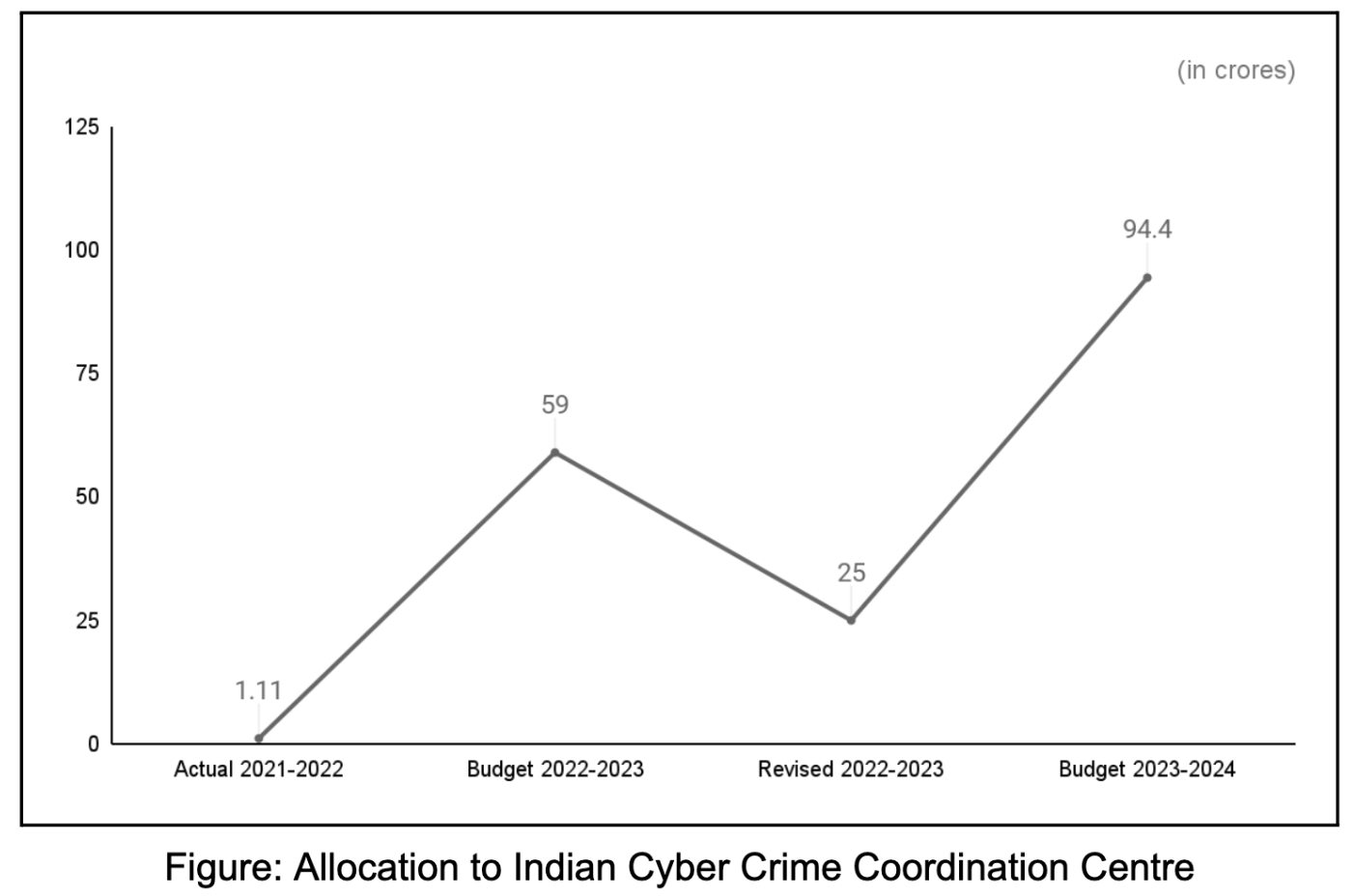
The modernisation of the Central Armed Police Forces which was introduced recently as a budget head in 2022-23, witnessed a 57.49% drop in its allocation from ₹ 621.45 in 2022-23 to ₹ 264.12 in 2023-24.
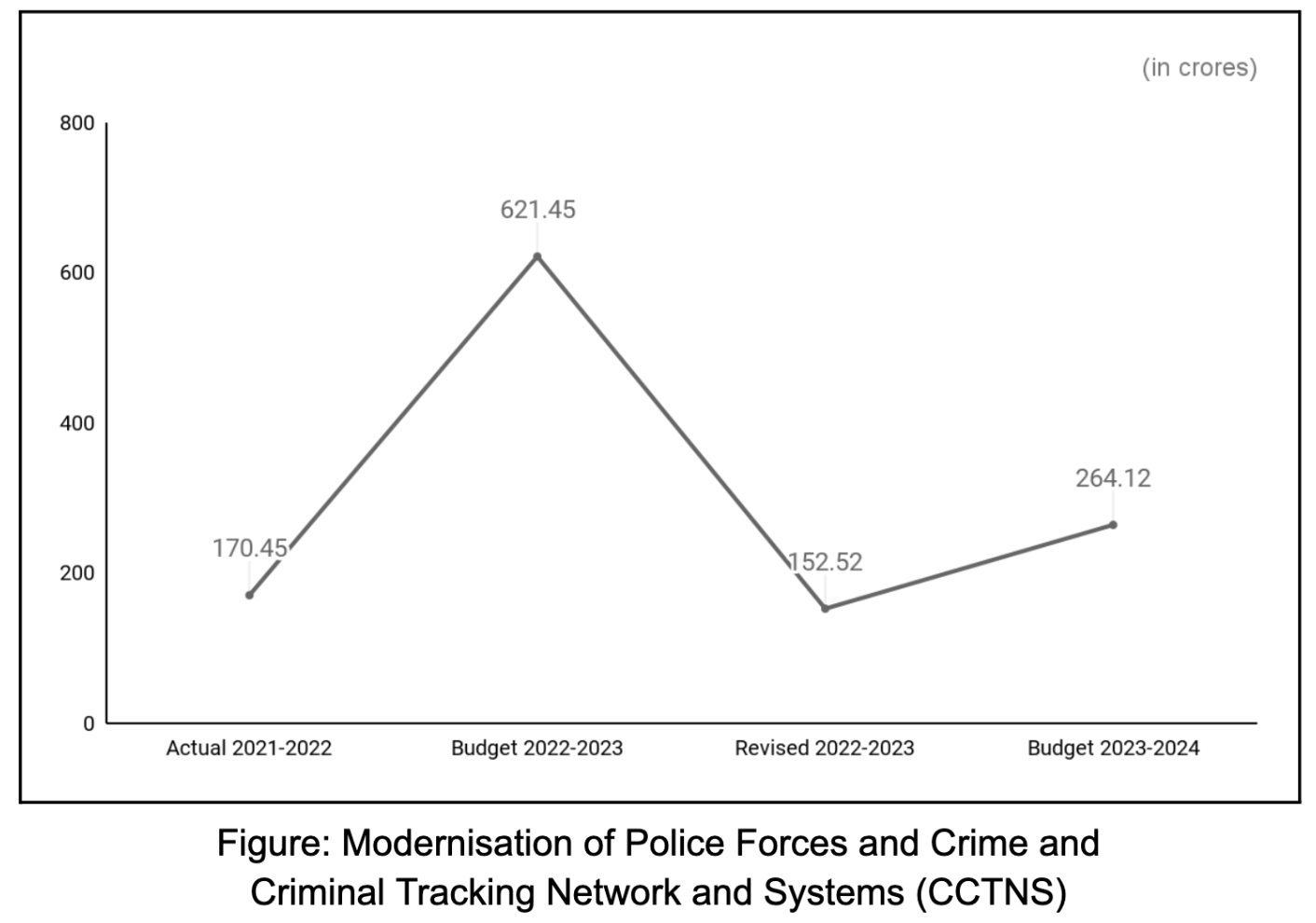
While the grant under Schemes for Safety of Women has improved considerably (60.5%), it is saddening to note a decreasing trend in the budget allocation for Cyber Crime Prevention against Women and Children and Miscellaneous Schemes, which has gone down to ₹ 120.78 crores in 2023-24 from ₹ 176.31 crores in 2022-23 indicating a drop of 31.49%.
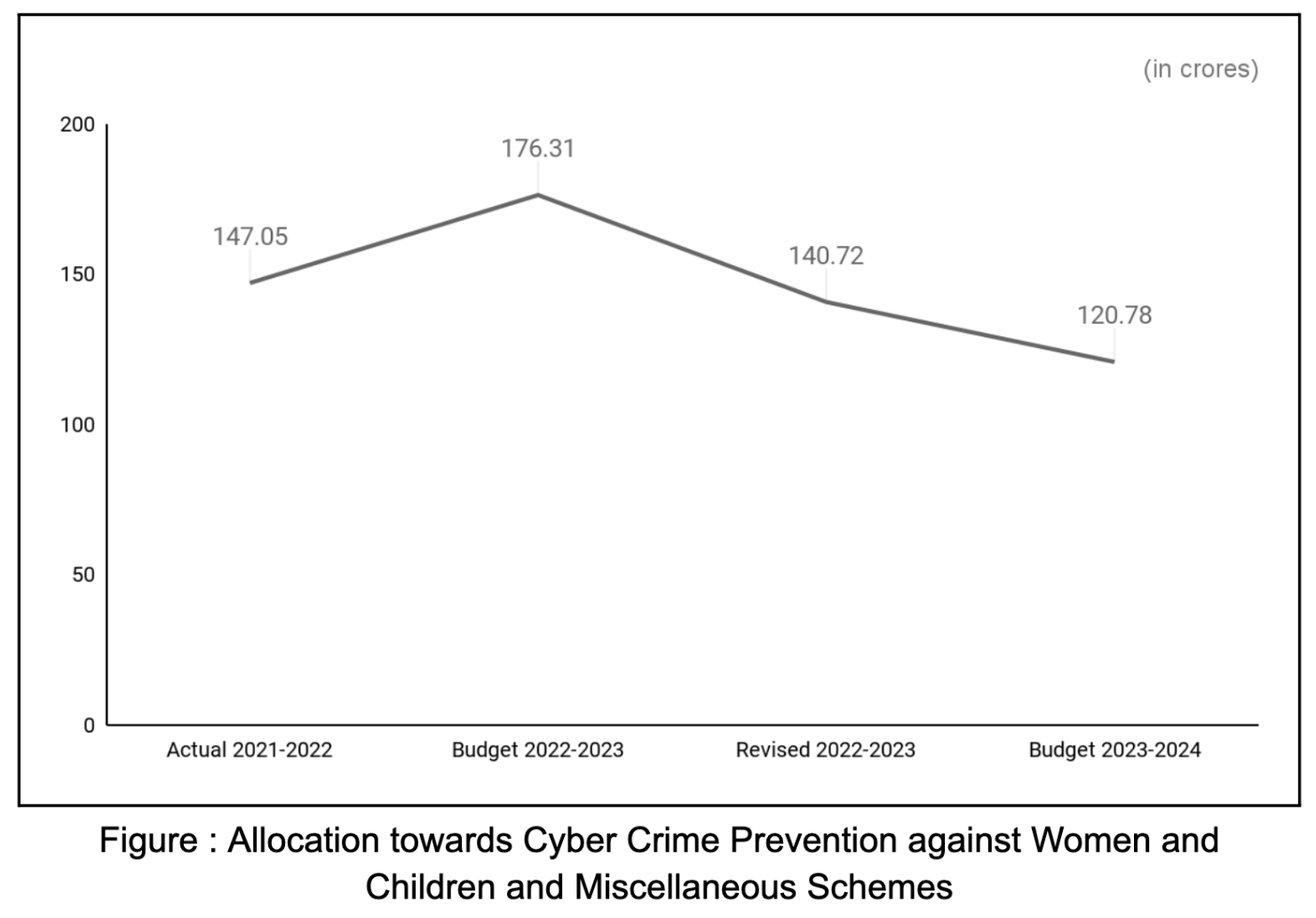
National Health Mission (NHM)
The allocation to NHM (₹ 341.02 crores) under the Ministry of Health and Family Welfare is 143% more than the RE 2022-23 (₹ 140 crores). Budgetary allocation to NHM in 2022-2023 also brought a pleasant surprise with a massive 166.6% increase.
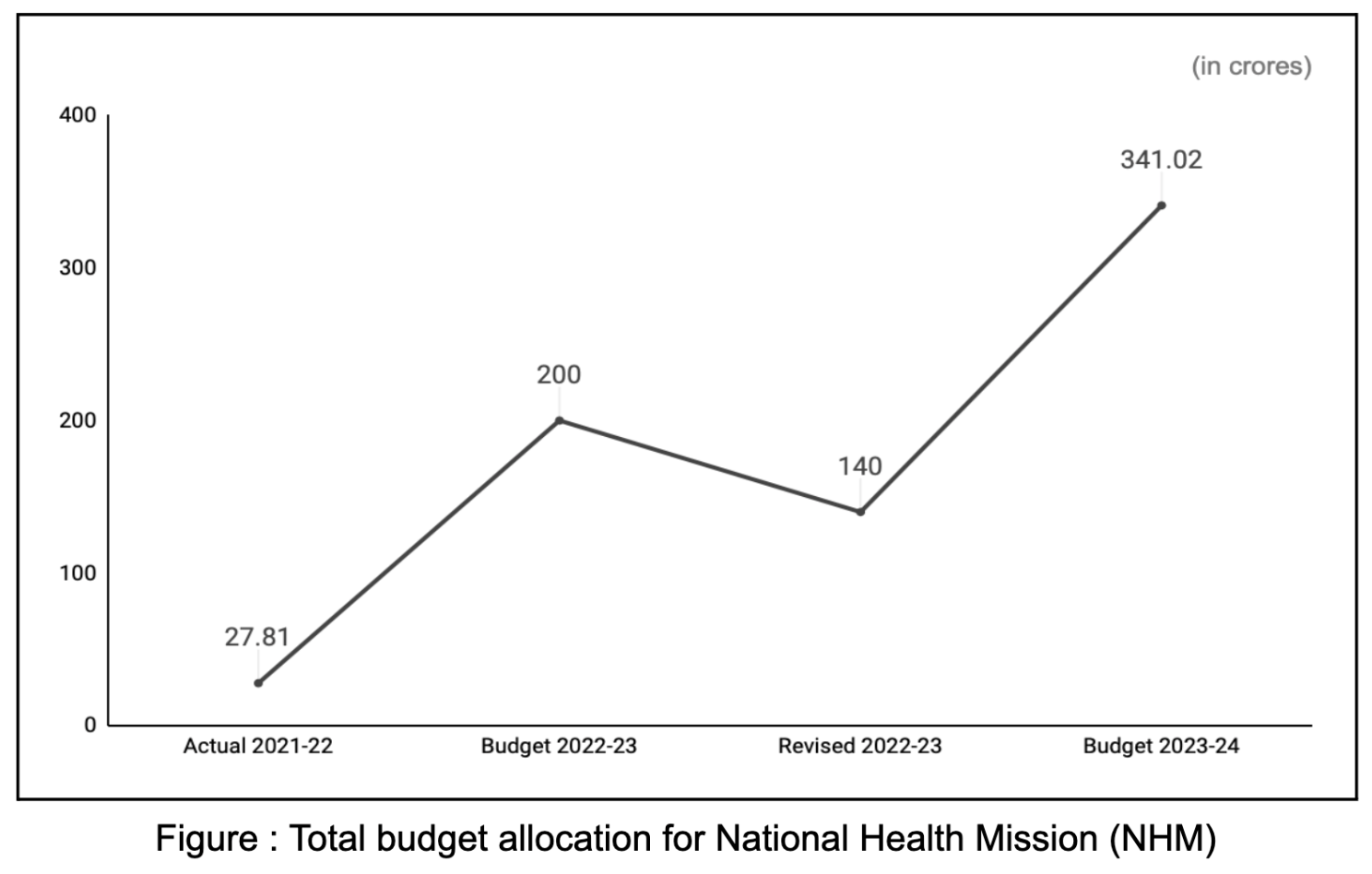
Ministry of Information and Broadcasting (MIB)
In another positive move, the total budgetary allocation for MIB witnessed a 17% increase from the 2022-2023 Budget, and a 12% increase from RE for 2022-2023. However, this increase must be perceived with a note of caution as the capital budgetary allocation has decreased by 10.86% in the current budget as compared to the previous revised budget. This reflects poorly on the MIB’s planned spending for the current financial year as the majority of its budget increase is targeted towards revenue expenditure.
Table 03: Budgetary allocations for specific items
MIB has increased the allocation under Total-Central Sector Schemes/Projects by 73% as compared to the Budgetary allocation in 2022-2023.
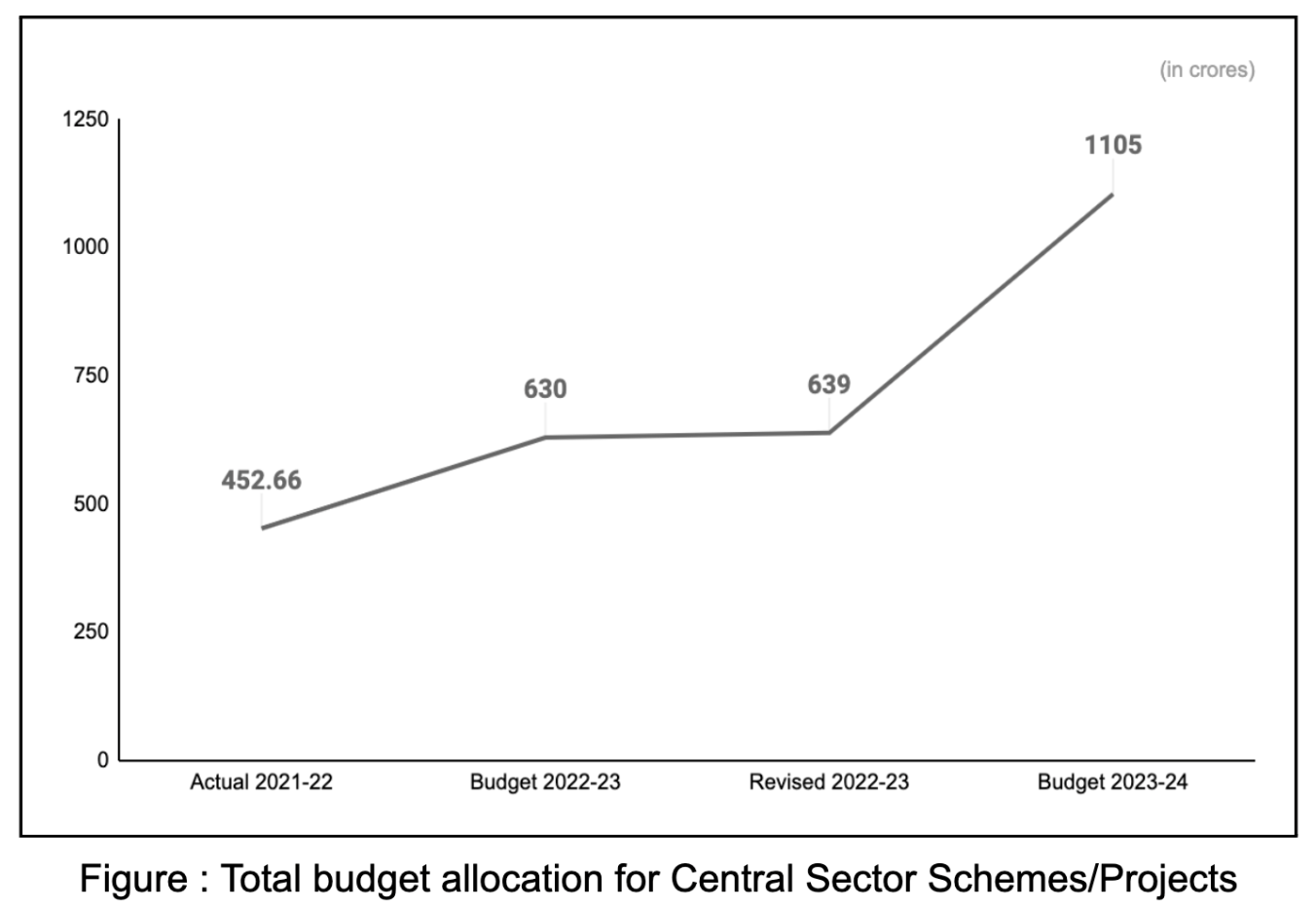
Department of Telecommunications (DoT)
In 2023-24, the Department has been allocated ₹ 97579.05, which is 15.35% increase over the budget allocated in 2022-23 (₹84586.80) and 19.25% over the RE 2022-23 (₹81821.11).
Table 04: Budgetary allocations for specific items
A 15.56% increase is seen in the budget allocated for the Universal Services Obligation Fund (USOF), which is ₹10,400 crores. This is admittedly a 15.56% increase from BE 2022-2023. However, a point of concern arises as out of ₹ 9,000 crores allotted last year, only ₹3,010 was retained in the RE, reflecting a decline of 66.33%.
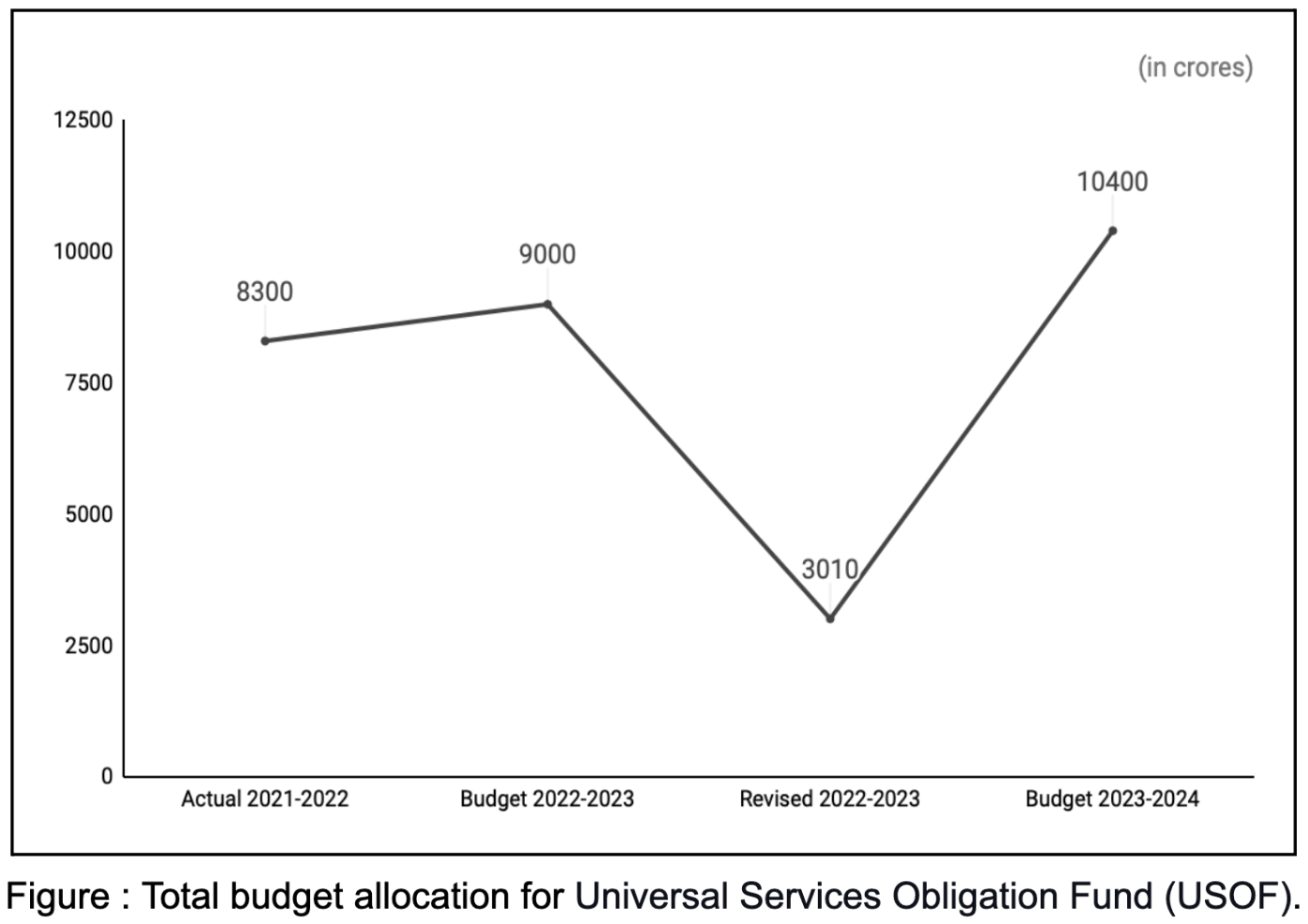
The total Budgetary allocation for DoT projects for the year 2023-2024 is ₹2285.32 crores, which is a 219.61% increase from the BE 2022-2023 and 448.86% from the RE 2022-2023. One of the key reasons for the increase in grant to the Department are the allocations made for the Domestic Industry Incentivisation Scheme (₹ 915 crores), wireless planning and coordination (₹756.42 crores) and digital intelligence unit project (₹220 crores). The Domestic Industry Incentivisation Scheme provides for Technology Development and Investment Promotion (₹55 crore), Champion Service Sector Scheme (₹60 crore) and Production Linked Incentive Scheme (₹800 crore). Allocation towards the Digital intelligence Unit (DIU) has significantly increased, receiving an allocation of ₹ 220 crores as opposed to only 10 crores in the previous year’s budget. The Project's objective is for investigating fraudulent activity involving telecom resources, such as Unsolicited Commercial Communication (UCC) etc.
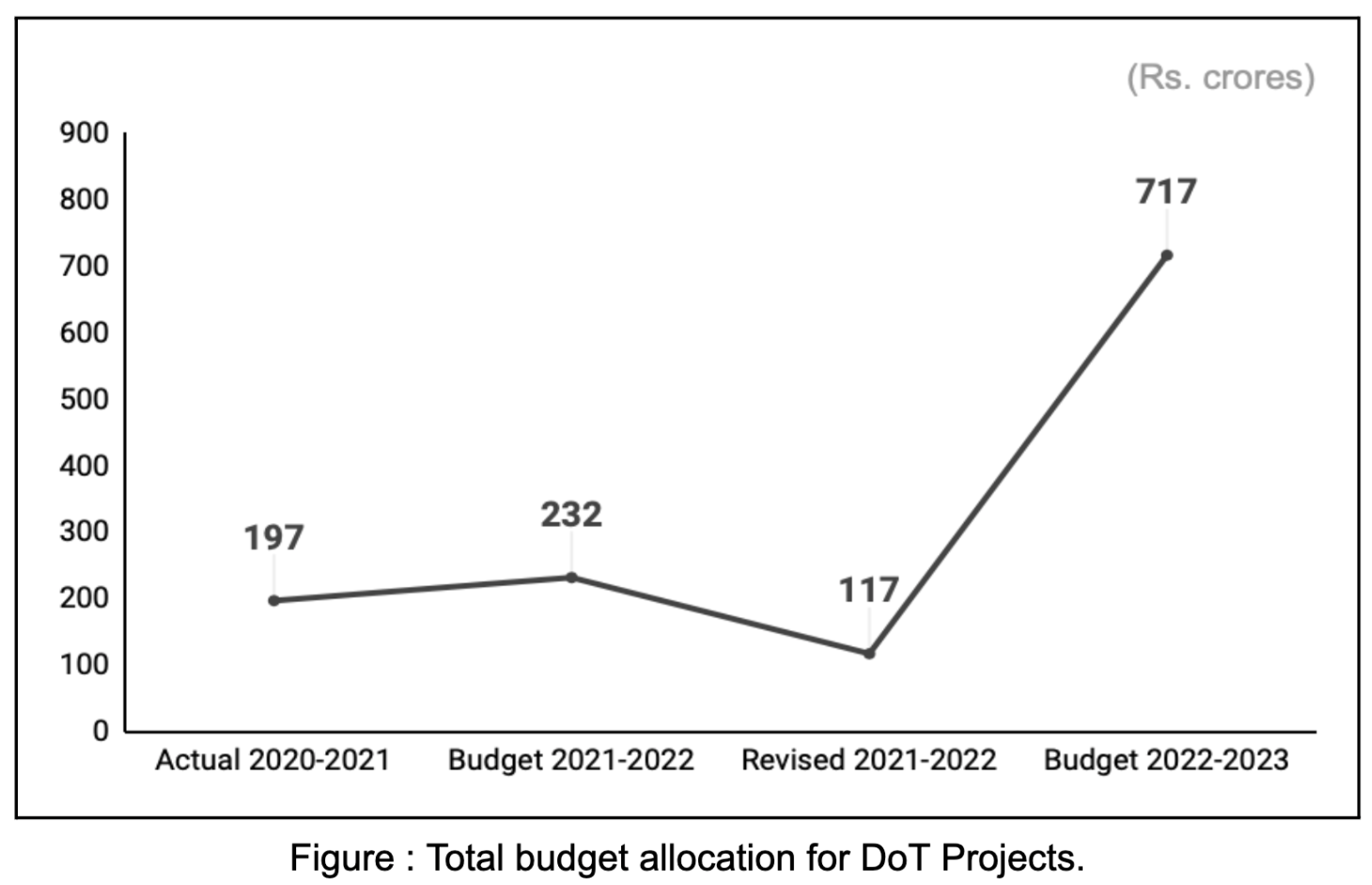
We note that there has been a 175.55% increase in BE 2023-24 (₹14843.32 crores) from RE 2022-23 (₹5386.73 crores) and 27.10% increase from BE 22-23 (₹11678) under Central Sector Schemes/Projects.
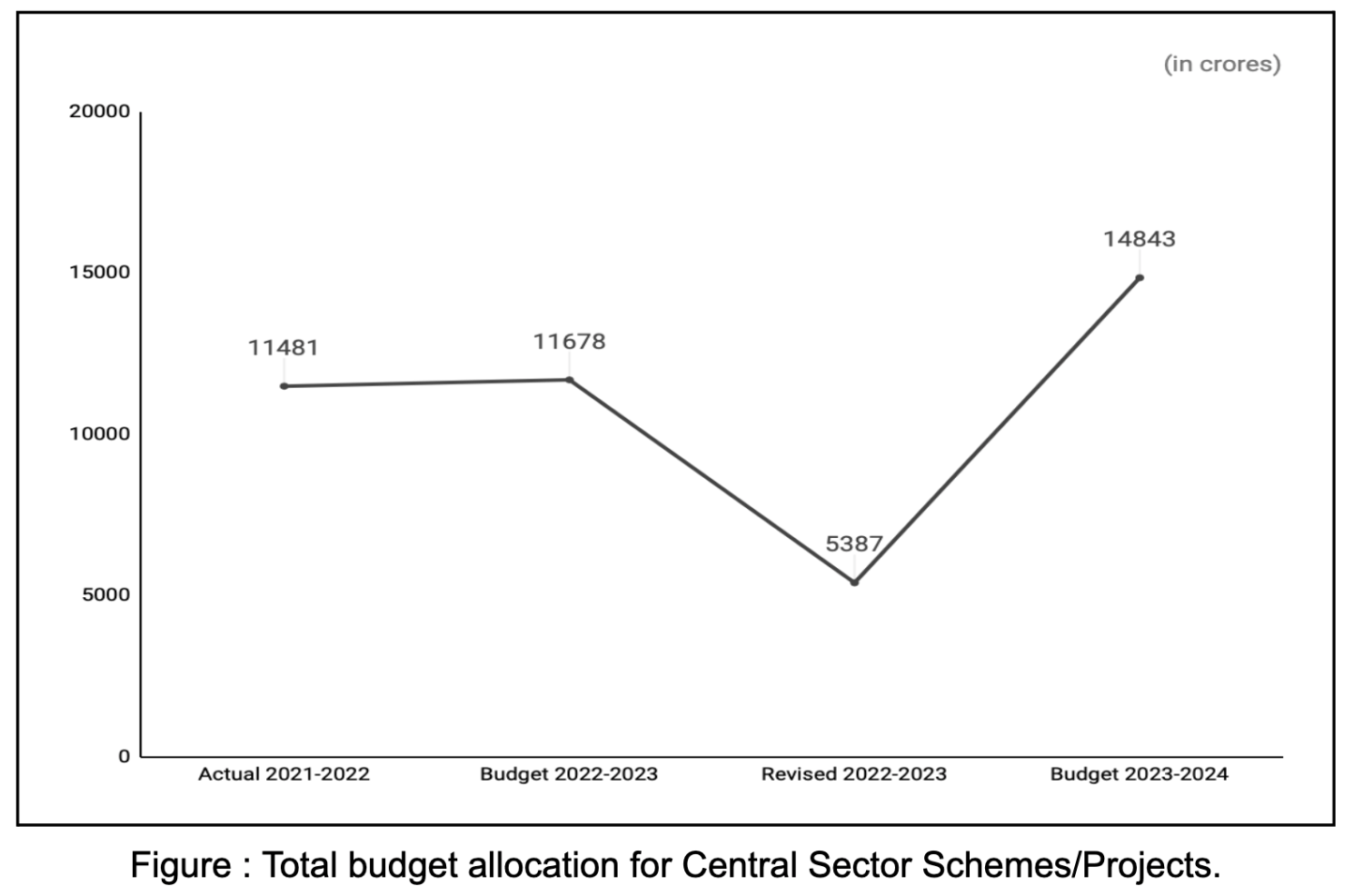
Capital Infusion in BSNL saw a rise of 59.11% in BE 2023-24 (₹52937) from RE 2022-23 (₹33269.01) and 18.37% from BE 22-23 (₹44270). The government intends to infuse ₹52,937 crore in state-run telecom carrier Bharat Sanchar Nigam Limited (BSNL) in FY24, higher than ₹44, 720 crore budgeted in FY23, mainly in areas of 4G spectrum, technology upgrading and restructuring in the fourth largest carrier.
As far as allocations for Bharatnet are concerned, there has been a significant increase of 233.33% in BE 2023-24 (₹5000 crores) from RE (₹1500 crores) and a decrease of 28.57% from BE 22-23 (₹7000 crores). The grant goes towards the creation of telecom infrastructure required for providing broadband connectivity to all the Gram Panchayats in the country and facilitating non-discriminatory access to service providers, for provisioning of broadband services in rural areas.
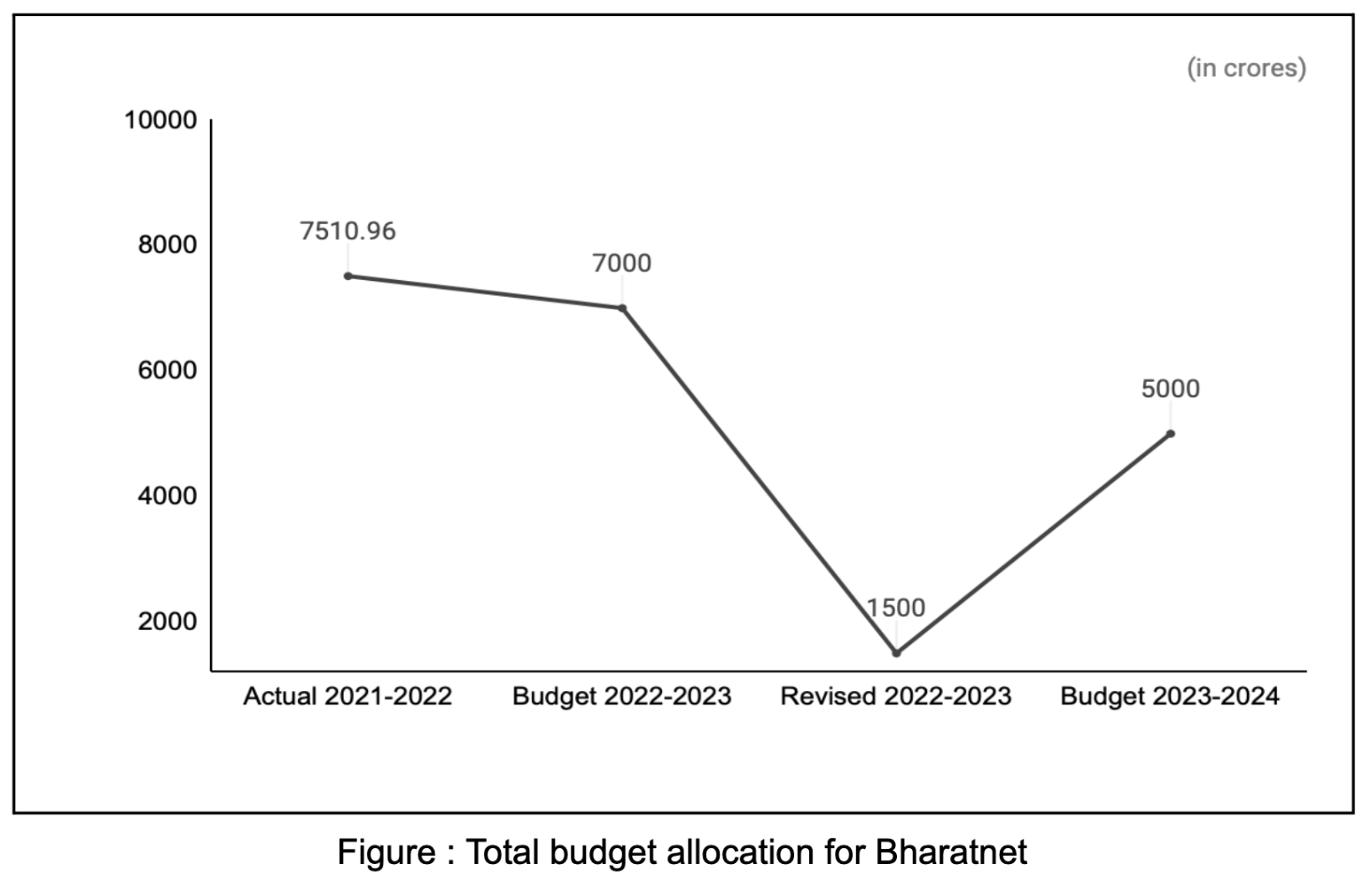
An allocation of ₹5.56 crores for 5G Connectivity test bed saw a decrease of 28.16% from RE 2022-23 (₹7.74). In light of this decrease, it remains to be seen how the Finance Minister acts on the goal of establishing 100 labs for developing applications using 5G services will be set up in engineering institutions to realise a new range of opportunities, business models, and employment potential, as noted in theher budget speech, will be achieved.
Certain exclusions in allocation have been done in this year’s budget for Champion services sector scheme, Production Linked Incentive (PLI) Scheme to Promote Telecom and Networking Products Manufacturing in India, Domestic industry investigation scheme, establishment of satellite gateway (assistance to BSNL), swachhta action plan, Capital infusion in MTNL for 4G Spectrum.
Conclusion
Overall, it is a mixed bag. While there are some notable highs, there are some disappointing lows as well. The additional cause for concern is the decrease in the AE as compared to the RE, and in the RE as compared to the BE. The RE indicates how much is possible for the government to extend to the concerned sector and the AE indicates how much was actually extended. While some variation among the three is inevitable, too much of a difference can reduce credibility of the numbers and cause uncertainty. Cuts in the RE and actuals may also negatively affect the implementation of government schemes and projects. In light of the increasing digitisation across sectors and the increasing demand for improved digital literacy as well as access to digital services, we hope that the fund allocation in these concerned sectors continue to witness a positive trend. We can thus only hope that in the coming years we witness a positive trend in budget allocation and utilisation.


